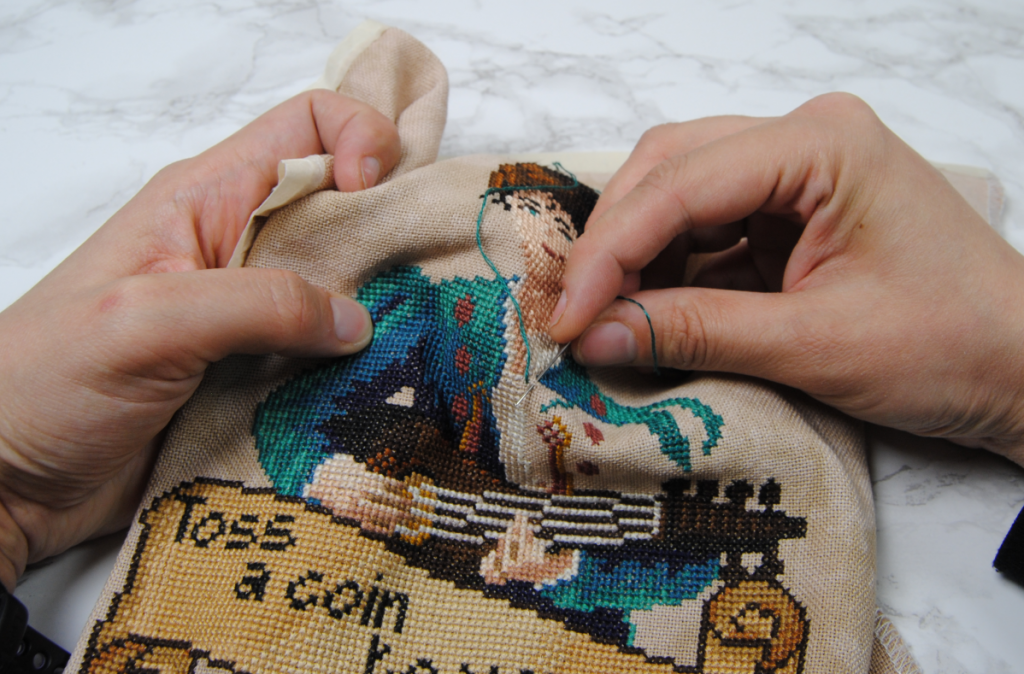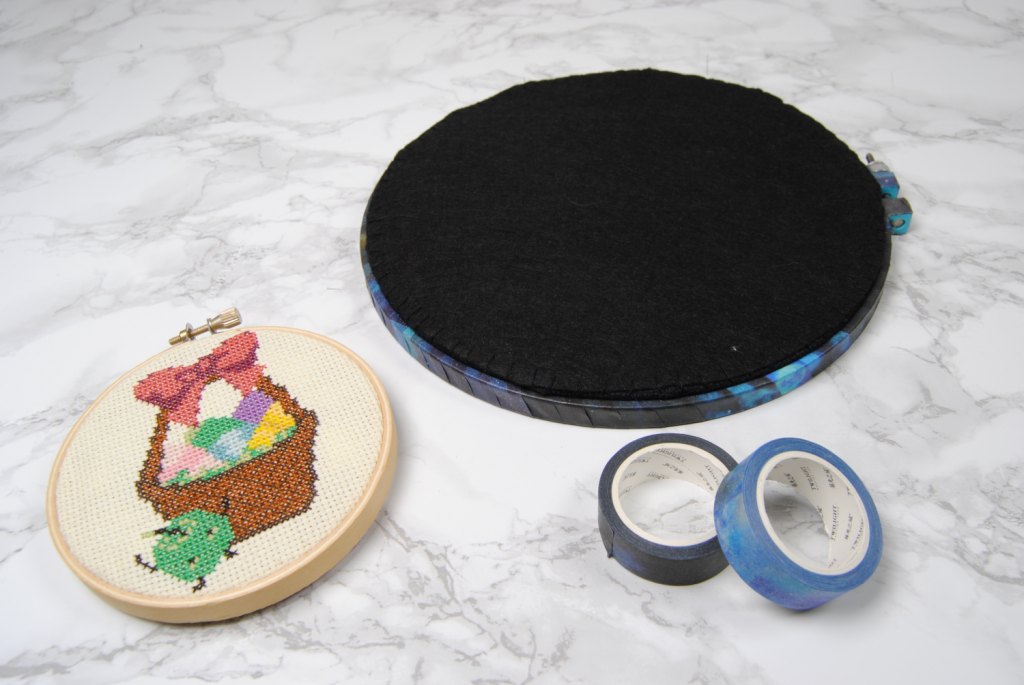Whether you’re a beginner or a long time stitcher you already have a preferred method for cross stitching. Whether you realize it or not. You make your Xs a specific way. It’s possible you have a favorite place to stitch in. You have a preferred fabric count. Perhaps you already use a Q-snap or a hoop. These are all ways in which our craft differ, and we embrace those differences when sharing our own preferences with others.
Why, then do we spend often spend so much time agonizing over whether we’re stitching ‘correctly’? Comparing ourselves to others and their preferred methods.
This post may contain affiliate links. If you buy something using one of these links, I earn a small commission. However, there is no extra cost to you. Thanks for understanding! Learn more in my Disclosures & Privacy Policy.
I mentioned this briefly in my Cross Stitch Beginner’s Guide, but I believe that there is no wrong way to stitch. That said, it’s important for you as a stitcher to try out various methods in order to figure out which one is right for you. So here’s just a few of the more popular ways to hold your fabric while you stitch.
Table of Contents
Stitching In Hand
Let’s go ahead and get this out of the way early. Stitching “In Hand” refers to simply holding the fabric yourself. In your hand. No fancy tools or stands.

For some reason long time stitchers seem to believe this method is “wrong.” And often are very vocal about it. So many new stitchers seem to believe they need to run out and get a hoop first thing in order to stitch ‘properly’.
Well I’m here to tell you it’s okay. Especially when you’re first starting out and don’t know whether this is even a craft you enjoy. There’s no need to spend extra money if you’re not going to be here long term. Even if you are here to stay, how will you understand why a Q-snap is so wonderful if you’ve never tried stitching without one?
The main reason stitchers recommend getting something to hold your fabric is to keep tension. If tension isn’t properly kept, what can happen is that your Xs become uneven in size and skew a design. You can keep tension yourself while stitching in hand just by being mindful. Try to keep the fabric taut in the area you’re stitching. And try not to pull your thread too tight.

Even if you do normally use something to keep your fabric tight, there are benefits to stitching in hand once in a while. As an example, small patterns can more easily be worked in hand. If you’re using plastic canvas, perforated paper, or vinyl aida you won’t be able to use such tools. You’ll need to stitch in hand anyway!
You can stitch faster!
Another reason you might want to stitch in-hand is to use the sewing method. This actually allows you to stitch much faster than you would normally, but takes a lot of practice to master. It’s a way to stitch entirely from the front of your project. That way you don’t have to spend time reaching around to push the needle back up.
Regardless of your reason for stitching in hand, don’t let anyone tell you that you have to get a hoop. It certainly is helpful to have something to hold your project while you work. However, it is not required. That said, let’s talk about the pros and cons of each of them the common tools so you can decide if any of them are right for you.
Embroidery Hoops
The most commonly used method for holding your fabric is the embroidery hoop. These have been around for what feels like ages and is considered the ‘traditional’ way to sew. Embroidery hoops were patented in 1903.

You can get hoops in both wood and plastic, and older ones were even made of metal! The concept is the same. You get two concentric rings, the larger one having a small screw used to tighten the outer ring onto the fabric. By placing your fabric between the two rings, it holds your fabric in place while you stitch.
They come in all different sizes. You can use a large one that encompasses your entire project and use it as a frame. Or work with a smaller rings and just move it around as needed to work on your stitch.

I say rings, because circular hoops are the most common, but they do come in other shapes as well. They are designed to keep your fabric tight. Hoops are thin, light, and easy to hold. Though you can also get a stand to hold it for you.
You can frame your piece with a hoop, too!
The other benefit is that these hoops can also be used to hang your design afterwords. They now double as frames to display your finished piece in to give it an even more kitschy feel. You could even paint or tape your hoops to match your design!

Everything has downsides though, and I find that the tension gets loose as I work. I feel like I have to constantly re-tighten the screws. This is due to the the cheap hoops I have worked with, though. If you decide to use a hoop, you will want to invest in a well known brand. I’ve been recommended both Morgan hoops and Hardwicke manor by the kind folks on the Pixel Stitch Discord.
If you can only afford the cheap ones, that’s okay. Just keep in mind that you may need to tighten and adjust more often.
The other issue I have with hoops is the rings they leave on your fabric. Many already wash and iron their projects, but hoops make it pretty much a necessity. That is, unless you start with a hoop more than large enough to frame your piece.

Scroll Frames
Another way to hold your fabric is by using a scroll frame. This seems especially useful for larger projects that will probably take you a long time to finish. These were patented in 1994. They were likely created to resolve some of the issues people had with hoops.

Scroll frames come in plastic these days, but it’s still more common to find them made of wood. With modern frames, the two rods are split, allowing you to slide your fabric in between. You’ll roll the fabric around the rod and secure the rods in place with the outer clamps. This keeps your project securely in place.
There are also types of scroll frames that come with a strip of fabric stapled to the frame. With these, you would sew your fabric onto that strip before rolling it up.

Now before someone points out that I’ve loaded my project onto the frame ‘incorrectly’, you can also roll the fabric the other way, so that the front of the fabric is behind the bars. But that’s a matter of personal preference. If you get a scroll frame you should experiment with which makes more sense for you.
No more hoop marks!
Due to the rolling motion, you don’t get crease marks on your fabric like you would with a hoop. It’s also easier to find stands for them and may even come with a stand already.

The main downsides seem to be that some have trouble learning the motion of loading the fabric onto the frame. If not
straight on the frame, it can cause the fabric to bubble in areas and throw off your tension. And it can take a few attempts if you’re just starting out.
Others have noted that the sides of the fabric that aren’t held in the rods tend to sag. That is easily remedied with some elastic clips. So don’t let that hold you back!
Q-snap
Lastly, my personal favorite of the bunch. The Q-snap. Now, when I say Q-snap I mean the specific brand of plastic clip frames. They’ve become synonymous with snap frames and some see it almost interchangeable. Most would sooner ask for a Q-Tip than a ‘cotton swab’ even if you don’t buy that specific brand. Q-snaps are the same way.

Whether you get an official Q-snap or not, you’re looking for a square plastic pipe with pvc clamps. You can find them as small as 6″x6″ and up to huge quilt sized 24″x36″. With extensions you could make one even larger than that!
Be wary of off-brands
You can opt for a cheaper off brand, such as in-store brands at your local craft chain. You can also order knockoffs online. But keep in mind many of the off-brands do not hold the fabric as well. Some have reported them leaving white strips on the fabric, or simply not holding together very well.
Q-snaps work by placing your fabric over the inner frame, and using the clamps to clip it in place. I find these easier to hold due to their thickness. It also comes apart, which means it can be easily stored away or taken on the go.

The clamps are easy to clip on and remove. This makes it easy to shift your project around to the area you’re working on next. They also don’t leave the same creases a hoop would.
As an added benefit, you can fold the fabric over and clip the extra in place too. This way you don’t have to deal with a bunch of extra fabric while you work. This may also help keep tension if you have a loose off-brand one. Or you can place small rectangles of felt there instead to protect your piece if you prefer.

Some find the thickness a downside, though. If you feel uncomfortable holding a thick frame, you may be better off with a hoop.
Q-snap stands
Another downside for some is that stands aren’t as as easily available for these guys yet. You might have trouble finding a pre-built one with a clamp thick enough to hold a Q-snap in place.

Despite that, you may also choose to make your own stand out of PVC piping as pictured above. There’s a lot of different styles and designs that people have made over the years. Be sure to search for Q-snap stands online to get an idea of how you want it to look before you start building!
So which should you use?
All of these tools have been used and loved by many. None of them are better than the others as a whole. But unless you give them each a try, you may never know which one is best for you.







